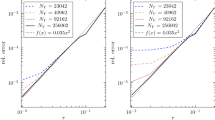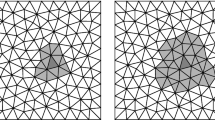Abstract
It is known that discrete sets of uniformly distributed points on the hypersphere \(\mathbb {S}^{d}\subset \mathbb {R}^{d+1}\) can be obtained from minimizing the energy functional corresponding to Riesz s-kernels \(k_s(\boldsymbol {x},\boldsymbol {y})=\lVert \boldsymbol {x}-\boldsymbol {y}\rVert ^{-s}\) (s > 0) or the logarithmic kernel \(k_{\log }(\boldsymbol {x},\boldsymbol {y})=-\log \lVert \boldsymbol {x}-\boldsymbol {y}\rVert +\log 2\). We prove the same for the kernel \(k_{\log }(\boldsymbol {x},\boldsymbol {y})=\lVert \boldsymbol {x}-\boldsymbol {y}\rVert (\log {\frac {\lVert \boldsymbol {x}-\boldsymbol {y}\rVert }{2}}-1)+2\) which is a front-extension of the sequence of derivatives \(k_{\log }, k_{1}, k_{2}, k_{3}, \dots \), up to sign and constants. The boundedness of the kernel simplifies the classical potential-theoretical proof of the asymptotic uniformity of the point distributions. Still, the property of a singular derivative for x → y is preserved, with the physical interpretation of infinite repulsive forces for touching particles. The quality of the resulting point distributions is exemplary compared with that of Riesz- and classical logarithmic point sets, and found to be competitive. Originally motivated by problems of high-dimensional data, the applicability of \(\log \)-optimal point sets with a novel concentric interpolation and differentiation scheme is demonstrated. The method is significantly optimized by the introduction of symmetrized kernels for both the generation of the minimum energy points and the spherical basis functions. Both the point generation and the Concentric Interpolation software are available as Open Source software and selected point sets are provided.
Similar content being viewed by others
References
Mardia, K.V., Jupp, P.E.: Directional Statistics. Wiley, London (2008). ISBN 9780470316979
Fritzen, F., Kunc, O.: Two-stage data-driven homogenization for nonlinear solids using a reduced order model. Eur. J. Mech. A. Solids 69, 201–220 (2018)
Dietrich, S., Gebert, J.-M., Stasiuk, G., Wanner, A., Weidenmann, K., Deutschmann, O., Tsukrov, I., Piat, R.: Microstructure characterization of CVI-densified carbon/carbon composites with various fiber distributions. Compos. Sci. Technol. 72(15), 1892–1900 (2012)
Pérez-Ramírez, Ú., López-Orive, J.J., Arana, E., Salmerón-Sánchez, M., Moratal, D.: Micro-computed tomography image-based evaluation of 3D anisotropy degree of polymer scaffolds. Comput. Methods Biomech. Biomed. Engin. 18(4), 446–455 (2015)
Morawiec, A.: Orientations and Rotations: Computations in Crystallographic Textures. Springer, Berlin (2004). ISBN 3540407340
Ma, J., Wang, C., Shene, C.-K.: Coherent view-dependent streamline selection for importance-driven flow visualization. In: Visualization and Data Analysis, 865407 (2013)
Martini, E., Carli, G., Maci, S.: A domain decomposition method based on a generalized scattering matrix formalism and a complex source expansion. Progress In Electromagnetics Research B 19, 445–473 (2010)
Roşca, D.: New uniform grids on the sphere. A&A 520, A63 (2010)
Staniforth, A., Thuburn, J.: Horizontal grids for global weather and climate prediction models: a review. Q. J. Roy. Meteorol. Soc. 138(662), 1–26 (2012)
Andelfinger, P., Jünemann, K., Hartenstein, H.: Parallelism potentials in distributed simulations of kademlia-based peer-to-peer networks. In: Proceedings of the 7th International ICST Conference on Simulation Tools and Techniques, SIMUTools ’14, ICST (Institute for Computer Sciences, Social-Informatics and Telecommunications Engineering), Brussels, Belgium, 41–50 (2014)
Lovisolo, L., Da Silva, E.: Uniform distribution of points on a hyper-sphere with applications to vector bit-plane encoding. IEE Proceedings-Vision, Image and Signal Processing 148(3), 187–193 (2001)
Saff, E.B., Kuijlaars, A.B.J.: Distributing many points on a sphere. Math. Intell. 19(1), 5–11 (1997)
Weyl, H.: ÜBer die Gleichverteilung von Zahlen mod. eins. Math. Ann. 77 (3), 313–352 (1916)
Landkof, N.S.: Foundations of Modern Potential Theory, vol. 180 of Grundlehren der mathematischen Wissenschaften. Springer, Berlin (1972)
Brauchart, J.S., Grabner, P.J.: Distributing many points on spheres: Minimal energy and designs. J. Complex. 31(3), 293–326 (2013). oberwolfach
Hardin, D., Saff, E.: Minimal Riesz energy point configurations for rectifiable d-dimensional manifolds. Adv. Math. 193(1), 174–204 (2005)
Esmaeilbeigi, M., Chatrabgoun, O., Shafa, M.: Scattered data fitting of Hermite type by a weighted meshless method. Adv. Comput. Math. 44(3), 673–691 (2018)
Brauchart, J., Hardin, D., Saff, E.: The next-order term for optimal Riesz and logarithmic energy asymptotics on the sphere. Contemp. Math 578, 31–61 (2012)
Christensen, J.P.R.: On some measures analogous to haar measure. Math. Scand. 26(1), 103–106 (1970)
Fritzen, F., Kunc, O.: GitHub repository MinimumEnergyPoints. https://github.com/EMMA-Group/MinimumEnergyPoints (2018)
Womersley, R.: Minimum energy points on the sphere S 2, Last updated 24-Jan-2003 https://web.maths.unsw.edu.au/~rsw/Sphere/ (2003)
Hardin, R.H., Sloane, N.J.A., Smith, W.D.: Minimal Energy Arrangements of Points on a Sphere, Last modified June 1 1997 http://neilsloane.com/electrons/ (1997)
Marsaglia, G.: Choosing a point from the surface of a sphere. Ann. Math. Statist. 43(2), 645–646 (1972)
Leopardi, P.: A partition of the unit sphere into regions of equal area and small diameter. Electron. Trans. Numer. Anal. 25(12), 309–327 (2006)
Ballinger, B., Blekherman, G., Cohn, H., Giansiracusa, N., Kelly, E., Schürmann, A.: Experimental study of Energy-Minimizing point configurations on spheres. Exp. Math. 18(3), 257–283 (2009)
Shewchuk, J.R.: Applied Computational Geometry: Towards Geometric Engineering, vol. 1148 of Lecture Notes in Computer Science, Springer-Verlag, 203–222, from the First ACM Workshop on Applied Computational Geometry. In: Lin, M.C., Manocha, D. (eds.) (1996)
Si, H.: TetGen, a delaunay-based quality tetrahedral mesh generator. ACM Trans. Math. Softw. 41(2), 11:1–11:36 (2015). ISSN 0098-3500
Hesse, K., Sloan, I.H., Womersley, R.S.: Numerical Integration on the Sphere, pp 1185–1219. Springer, Berlin (2010)
Narcowich, F.J., Petrushev, P., Ward, J.D.: Localized tight frames on spheres. SIAM J. Math. Anal. 38(2), 574–594 (2006)
Kuijlaars, A., Saff, E.: Asymptotics for minimal discrete energy on the sphere. Trans. Am. Math. Soc. 350(2), 523–538 (1998)
Cohn, H., Kumar, A.: Universally optimal distribution of points on spheres. J. Am. Math. Soc. 20(1), 99–148 (2007)
Fritzen, F., Kunc, O.: Github repository ConcentricInterpolation https://github.com/EMMA-Group/ConcentricInterpolation (2018)
Sommariva, A., Womersley, R.: Integration by RBF over the sphere, Applied Mathematics Report AMR05/17, U. of New South Wales
Fasshauer, G.E., Schumaker, L.L.: Scattered data fitting on the sphere, Mathematical Methods for Curves and Surfaces II, pp 117–166 (1998)
Sloan, I.H., Womersley, R.S.: Constructive polynomial approximation on the sphere. Journal of Approximation Theory 103(1), 91–118 (2000)
Womersley, R.S., Sloan, I.H.: How good can polynomial interpolation on the sphere be?. Adv. Comput. Math. 14(3), 195–226 (2001)
Wang, Y.G., Gia, Q.T.L., Sloan, I.H., Womersley, R.S.: Fully discrete needlet approximation on the sphere. Appl. Comput. Harmon. Anal. 43(2), 292–316 (2017)
Fasshauer, G., McCourt, M.: Kernel-based approximation methods using MATLAB, vol. 19 World Scientific Publishing Company (2015)
Morris, M.D., Mitchell, T.J., Ylvisaker, D.: Bayesian design and analysis of computer experiments use of derivatives in surface prediction. Technometrics 35(3), 243–255 (1993)
Tumanov, A.: Minimal biquadratic energy of five particles on a 2-sphere. Indiana University Mathematics Journal 62(6), 1717–1731 (2013)
Rashidinia, J., Fasshauer, G., Khasi, M.: A stable method for the evaluation of Gaussian radial basis function solutions of interpolation and collocation problems. Computers & Mathematics with Applications 72(1), 178–193 (2016)
Wright, G.B., Fornberg, B.: Stable computations with flat radial basis functions using vector-valued rational approximations. J. Comput. Phys. 331, 137–156 (2017)
Fuselier, E., Hangelbroek, T., Narcowich, F.J., Ward, J.D., Wright, G.B.: Localized bases for kernel spaces on the unit sphere. SIAM J. Numer. Anal. 51(5), 2538–2562 (2013)
Narcowich, F.J., Sun, X., Ward, J.D., Wendland, H.: Direct and inverse Sobolev error estimates for scattered data interpolation via spherical basis functions. Found. Comput. Math. 7(3), 369–390 (2007)
Leopardi, P.: Discrepancy, separation and Riesz energy of finite point sets on compact connected Riemannian manifolds, Dolomites Research Notes on Approximation 6
Smale, S.: Mathematical problems for the next century. Math. Intell. 20(2), 7–15 (1998)
Nerattini, R., Brauchart, J.S., Kiessling, M.K.-H.: Optimal $N$-Point configurations on the sphere: “Magic” numbers and Smale’s 7th problem. J. Stat. Phys. 157(6), 1138–1206 (2014)
Damelin, S.B., Hickernell, F.J., Ragozin, D.L., Zeng, X.: On energy, discrepancy and group invariant measures on measurable subsets of euclidean space. J. Fourier Anal. Appl. 16(6), 813–839 (2010)
Acknowledgments
The authors thank the anonymous reviewers for valuable comments.
Funding
This work was funded by the Deutsche Forschungsgemeinschaft (DFG, German Research Foundation) FR2702/6 (grant no. 257987586) and FR2702/8 (grant no. 406068690) in the scope of the Emmy-Noether and Heisenberg funding lines. Oliver Kunc also received funding by the DFG within the Cluster of Excellence in Simulation Technology (EXC 310/2, grant no. 50131014, Project PN1-23) at the University of Stuttgart.
Author information
Authors and Affiliations
Corresponding author
Ethics declarations
Conflict of interest
The authors declare that they have no conflict of interest.
Additional information
Communicated by: Robert Schaback
Publisher’s note
Springer Nature remains neutral with regard to jurisdictional claims in published maps and institutional affiliations.
Data availability
All of the point sets used in the numerical examples are available in the MATLAB software package’s subfolder examples/exports (see [20]), and in the C++ software packages subfolder data/directions (see [32]).
Appendices
Appendix 1. Generation of random points on \(\mathbb {S}^d\)
The generation of uniformly random points on \(\mathbb {S}^d\), can be realized in several ways. Two prominent and convenient examples include:
Generation using the normal distribution\({\mathcal N}\) (cf. [23]) The easiest way of generating the sought-after points is based on random variables ni following a normal distribution \(\mathcal {N}\). A point \(\boldmath {x}\in \mathbb {S}^{d}\) is obtained by setting the components of its coordinate vector \(x_i \sim \mathcal {N}\) (\(i=1, \dots , d+1\)), followed by normalization of the whole vector. A purely technical improvement of the algorithm is to abandon random samples which have a vector norm close to machine precision before the normalization in order to prevent numerical truncation.
Generation using the uniform distribution\({\mathcal U}\)on [− 1, 1] Another option is to seed all components of candidate points according to a uniform distribution \({\mathcal U}\) on the interval [− 1, 1]. Next, points having a norm greater than 1 and smaller than a tolerance determined by machine precision are rejected, i.e., only points contained in a spherical shell are accepted. The remaining points are then projected onto \(\mathbb {S}^{d}\).
The advantage of the method relying on random variables following a normal distribution is that there is virtually no rejection while the second algorithm will lead to a substantial amount of rejected points: for d = 1 the chance for rejection is 21.46%, for d = 2 it is 47.64% and for arbitrary spherical dimension d it is defined by
where Ld+ 1 denotes the Lebesgue measure in \(\mathbb { R}^{d+1}\) and \(\mathbb { B}^{d+1}=\{\boldmath { x}\in \mathbb { R}^{d+1}:\lVert \boldmath { x}\rVert \leq 1\}\). Since Gaussian random variables are available at little numerical expense in many software libraries, the first algorithm is available as an option in the graphical user interface of our MATLAB software. If it is selected, the resulting point set is passed to Algorithm 1 as initial configuration.

Appendix 2. Algorithms
For Algorithm 2, the quantity \(\widetilde {f}_{\gamma }\) denotes the surrogate model \(\widetilde {f}\) (cf. (CI)), with respect to the kernel function \(\widetilde {k}(z_{\mathrm {g}})=\exp (-\gamma z_{\mathrm {g}}^2)\), approximating the original function f.

Rights and permissions
About this article
Cite this article
Kunc, O., Fritzen, F. Generation of energy-minimizing point sets on spheres and their application in mesh-free interpolation and differentiation. Adv Comput Math 45, 3021–3056 (2019). https://doi.org/10.1007/s10444-019-09726-5
Received:
Accepted:
Published:
Issue Date:
DOI: https://doi.org/10.1007/s10444-019-09726-5
Keywords
- Points on spheres
- Uniform distribution
- Minimum energy points
- Riesz kernel
- Logarithmic kernel
- Mesh-free interpolation
- Kernel interpolation
- Numerical differentiation
- High-dimensional data




